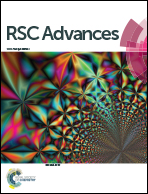Spongy nitrogen-doped activated carbonaceous hybrid derived from biomass material/graphene oxide for supercapacitor electrodes†
Abstract
Carbon derived from low cost agricultural waste material was used as a precursor for the preparation of a spongy-like nitrogen doped activated composite from carbon/graphene oxide via a one-step thermal treatment. N-doping and activation of the carbon/graphene oxide mixture were achieved simultaneously by the treatment of urea and potassium hydroxide at 800 °C. The nitrogen content and ratio between the nitrogen species was controlled by the mass ratio of KOH : carbon. The composite was prepared with a KOH : carbon ratio of 1 which resulted in a moderate surface area (1712.4 m2 g−1) and a high nitrogen content (14.51%). The hybrid material gave high specific capacitance (267 F g−1 at 5 mV s−1) and good cycling stability (92.3% capacitance retention after 5000 cycles) in 6 M KOH electrolyte. Hence, the new composite presented in this work can be used as an advanced material for supercapacitor applications.


 Please wait while we load your content...
Please wait while we load your content...